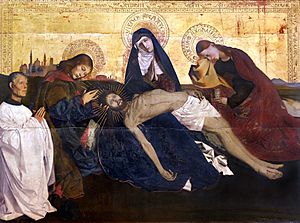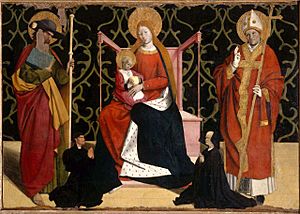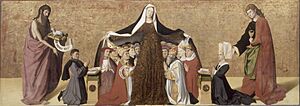Enguerrand Quarton facts for kids

Enguerrand Quarton (or Charonton) (around 1410 – around 1466) was an important French painter and a creator of beautiful handwritten books. Even though only a few of his artworks still exist, they are considered masterpieces. His style was very unique, standing out from Italian or Dutch paintings of his time.
We know of six paintings he created, but only two are still around. The famous Avignon Pietà in the Louvre museum is now believed by most art experts to be his work. His two confirmed paintings are the amazing Coronation of the Virgin (painted 1453–1454) and The Virgin of Mercy (painted 1452).
Contents
Life as an Artist
Enguerrand Quarton was born in northern France, near a place called Laon. In 1444, he moved to a region in southern France called Provence. He might have worked in the Netherlands before this move. In Provence, he lived and painted in cities like Aix-en-Provence, Arles, and Avignon. He stayed in Avignon from 1447 until he passed away around 1466.
Provence was home to some of France's most impressive painters during this time. Artists like Nicolas Froment and Barthélemy d'Eyck also worked there, and it seems they sometimes collaborated with Quarton. These artists were influenced by both Italian and Dutch painting styles. Avignon was still an important city, even though the Popes no longer lived there. Many Italian merchants lived in the city, which brought new ideas and art styles.
Quarton created many works for important people in Provence. For example, the Chancellor of Provence asked him to create a special prayer book called the Missal of Jean des Martins.
For a long time, Enguerrand Quarton was almost forgotten. But then, in 1900, his Coronation of the Virgin painting was shown in Paris. Since then, people have realized how important his art is, and more works have been linked to him. The Avignon Pietà was only widely accepted as his work starting in the 1960s.
The Virgin of Mercy Painting
This painting is also known as the Cadard Altarpiece, named after the person who paid for it. It shows a common scene in art where the Virgin Mary protects people under her large cloak. This idea was often seen in Italian art.
The painting has a plain gold background, which was an older style for the 1450s. The sizes of the figures in the painting show their importance. The Virgin Mary and the saints are very tall, while the person who paid for the painting and his wife are a bit smaller. The people sheltered under Mary's cloak are the smallest. This way of showing size is called "hieratic scale."
A document from 1452 says that both Quarton and another artist named Pierre Villate would work on this painting. However, art experts find it hard to see two different artists' styles in the finished work. Some suggest that Villate might have painted the less important figures or perhaps a part of the artwork that is now missing.
The Coronation of the Virgin
The Coronation of the Virgin is a painting that shows the Virgin Mary being crowned in heaven. What makes this painting special is how it shows God the Father and Jesus Christ (the Son) looking exactly alike. This was very rare in the 1400s!
Around the Holy Trinity (Father, Son, and Holy Spirit), there are blue and red angels. Below them, you can see a wide landscape with the cities of Rome (on the left) and Jerusalem (on the right). The person who ordered the painting had visited both cities on a pilgrimage. Even further down, the painting shows Purgatory (a place of cleansing) on the left and Hell on the right. In the middle, the person who ordered the painting is kneeling before a Crucifixion scene.
On the far left, you can see a church drawn as if it's cut open, showing a special church service happening inside. Quarton had 17 months to finish this painting. The contract for this artwork is very detailed, describing exactly what should be painted and what materials to use. It's one of the most detailed contracts for medieval European painting that still exists!
Like many of Quarton's paintings, the landscapes in his art show the beautiful scenery of Provence. His figures, however, were more influenced by Dutch artists, but they have a unique French elegance and seriousness. His colors are very strong, and his lighting is bright and clear. This painting might be one of the first artworks to show Mont Sainte-Victoire, a mountain that later became famous in paintings by Cézanne. The painting stayed in a monastery for over 300 years and is now in a museum in Villeneuve-lès-Avignon.
The Pietà of Villeneuve-lès-Avignon
The Pietà is a common art theme that shows the dead body of Jesus being held by his grieving mother, Mary. This particular Pietà is considered one of the greatest masterpieces created in France in the 1400s.
The way Jesus's body is curved is very original. The other figures in the painting look calm and dignified, which is different from how Italian or Dutch artists usually showed such scenes. Before it was widely believed to be Quarton's work, some art experts thought it might have been painted by an artist from Spain or Portugal.
The background is a simple landscape that fades into the distance, with buildings of Jerusalem on the horizon. But instead of a sky, there's a plain gold background with patterns pressed into it. The person who ordered the painting, a clergyman, is shown kneeling on the left side with great realism. This painting came from Villeneuve-lès-Avignon, a town near Avignon, which is why it's sometimes called the "Villeneuve Pietà."
Illuminated Manuscripts
Enguerrand Quarton also created small paintings in illuminated manuscripts, which are handwritten books decorated with beautiful illustrations. His style in these miniatures is very distinct, especially in his use of colors and how he shaped figures.
In 1444, Quarton worked with Barthélemy d'Eyck on an unfinished Book of Hours (a type of prayer book). It seems that d'Eyck drew some of the pictures, and Quarton painted them. Quarton also did some miniatures entirely by himself.
Later, he worked on another Book of Hours and a large, fancy missal (a book used for church services) that was finished in 1466. This missal shows Quarton's fully developed style with many detailed miniatures. He also added two large miniatures to the famous Boucicaut Book of Hours.
See also
 In Spanish: Enguerrand Quarton para niños
In Spanish: Enguerrand Quarton para niños




